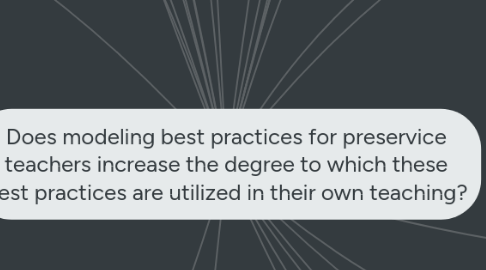
1. Videomodeling
1.1. Deiker, et. al 2009
1.2. Interactive Video
2. Case Methods (Outdated language?) see Merseth (1990s)
3. Lit Review
3.1. 32 results after filter (reading abstract)
3.1.1. Eliminated studies for which Modeling was part of the method, but not utilized as an IV.
3.2. Database search
3.2.1. ERIC
3.2.1.1. Preservice Teachers AND Model*
3.2.1.2. Preservice Teachers AND Scaffold*
3.2.1.3. Teacher Education Faculty AND Best Practices
3.2.1.4. Good Teaching AND Modeling AND preservice teachers
3.2.2. PsychInfo
3.2.2.1. Preservice Teachers AND Model*
3.2.2.2. Video Modeling AND Preservice Teacher*
3.2.3. Snowballing.
4. Need for link between theory and practice.
4.1. Explicit connection between model and theory enables the learning to go beyond "useful tricks" into a demonstration of theory --> Practice (Mieke Lunenberg
4.2. This is increasingly important given the contemporary trend in support of "research based practice."
4.3. Anderson's 6 Dimensions
5. New chapter: Explore means of implementation (see "Implementation Research: A review of the literature"
5.1. See Joyce & Showers
6. Moving target. Where Teacher faculty cannot model best practices themselves, use video modeling?
7. Methods for Research Design
7.1. Observe Teacher Educators (Faculty) for evidence of modeling, connection to student's own teaching, connection to theory (Mieke Lunenberg
7.1.1. "Member Check" after observation (Merriam 1997)
7.2. Cmparison or Control group? Comparison may be more valid, but how to do?
7.3. Design Exemplars
7.3.1. See Kennedy, et. al 2014 for design idea!
7.3.2. Dieker et sl 2009
7.4. Survey Ed Faculty about why they do or do not demonstrate/model best practices.
7.5. Group study effectiveness when this method IS used.
7.6. Validity Measures
7.6.1. Use of a Panel (eg. committee?) to assess content validity. (Cf. Spooner, Baker, Harris, et. al.)
7.6.2. Procedural fidelity checklists
7.6.3. Inter observer agreement (if necessary)
8. Preservice Teacher Beliefs
9. Teaching Teachers how to teach = content. Showing teachers how to teach = modelng. Those who can, teach, those who can't teach teachers?
9.1. Important to DEBRIEF / Think out loud about model to ensure students in fact recognize the modeling and have opportunity to consider its import. (Wubbels, Korthagen, and Broekman)
9.1.1. Dialogue about how modeling applies to specific cases.
9.2. Some instructional strategies are based on development and content. Not all are deemed "age appropriate" or content appropriate. How to address this?
9.2.1. Live modeling / Role Playing
9.2.1.1. Role playing sometimes seen as "childish" to Teacher Educators (Wideen et al. (1998)
9.3. Process of Teacher Education: Demonstrate, Articulate, Practice, Apply
10. NEW CHAPTER: Sub-study: case study examination of PT faculty to identify modeling (c.f. Lunenberg et al., 2007)
11. Best practices in education is a moving target. As faculty distance temporally from the classroom, the rift between what "WAS" best practice and what "IS" becomes wider. While it is easy to report on what one 'ought' to do, modeling is both more challenging and more effective. (Bell Interview)
12. Implicit vs. Explicit modeling
12.1. This could be a separate study or a subset.
13. ISSUES AND IDEAS
14. METHODS
15. Show and Tell: Modeling and Reflecting as a Critical (and Largely Absent) Tools in Teacher Education
16. Three Way Comparison: Explicit teaching vs. Video Modeling vs. Live Modeling
16.1. Possibly too big for dis.
17. Anchored instruction
18. Making Thinking Visible
18.1. "We teach as we are taught, not how we are taught to teach" (Blume, 1971).
18.2. (defined as learning within a meaningful, problem-solving context (Bransford, Sherwood, Hasselbring, Kinzer, & Williams, 1990).
19. Idea: use a HAT or other indicator when stepping outside the lesson to model teacher thinking.
20. Social Learning Theory
21. Inclusion
21.1. SET
21.2. UDL
21.2.1. Ralabate et al. (2012) examined UDL implementation at the state and local levels and found that although it enjoys broad recognition, and is included in many state technology plans, there is confusion about what UDL is, how it relates to other initiatives, and how to implement it.
21.2.2. UDL is difficult to describe in that there are no reliable, valid, or widely avail- able measures for universal screening, progress monitoring, implementation fidelity, or outcome assessments (Edyburn, 2010).

